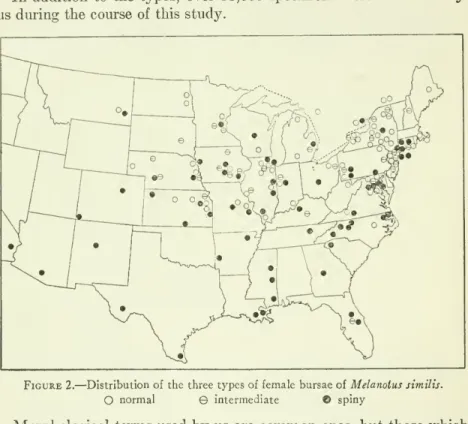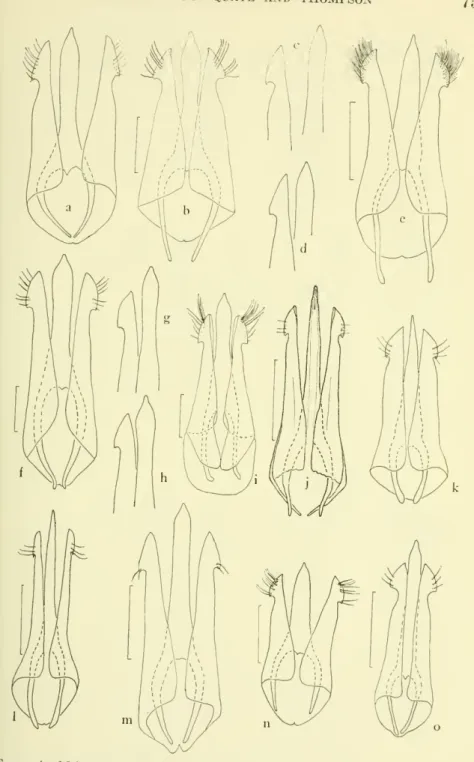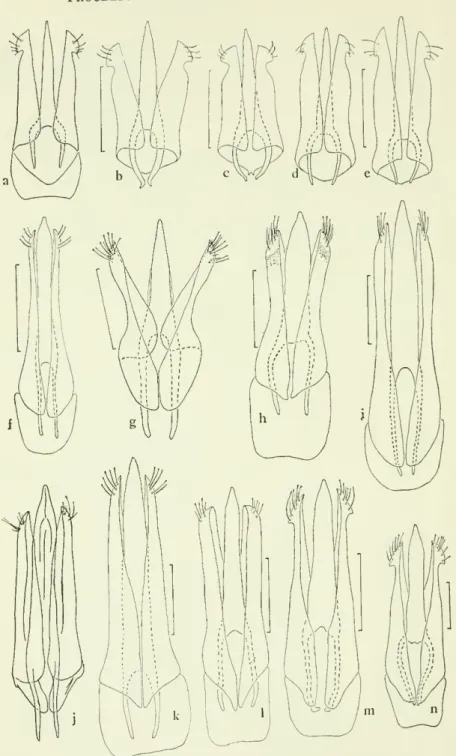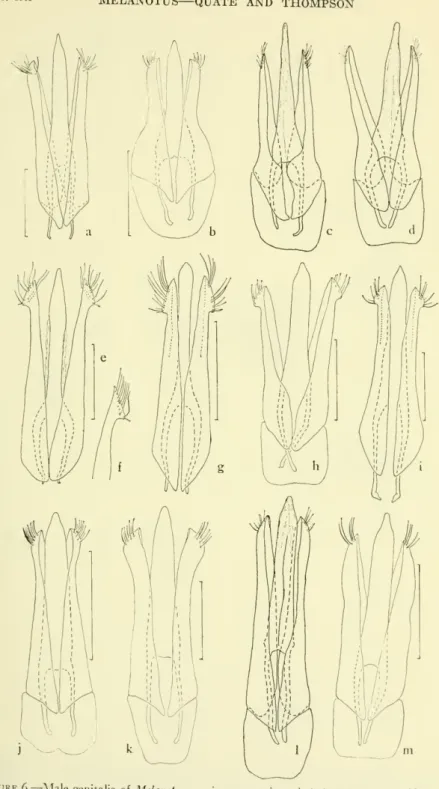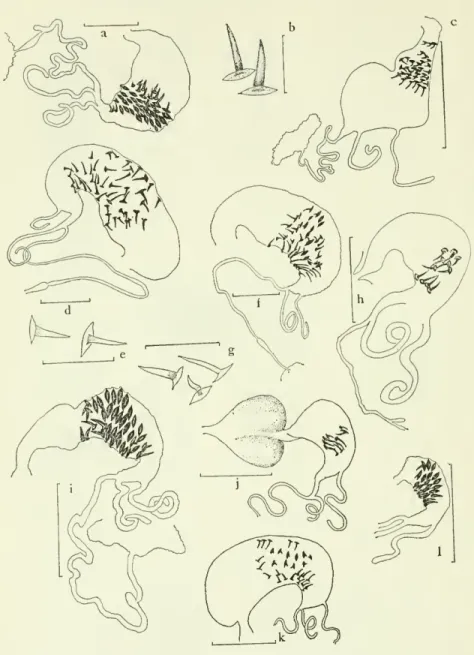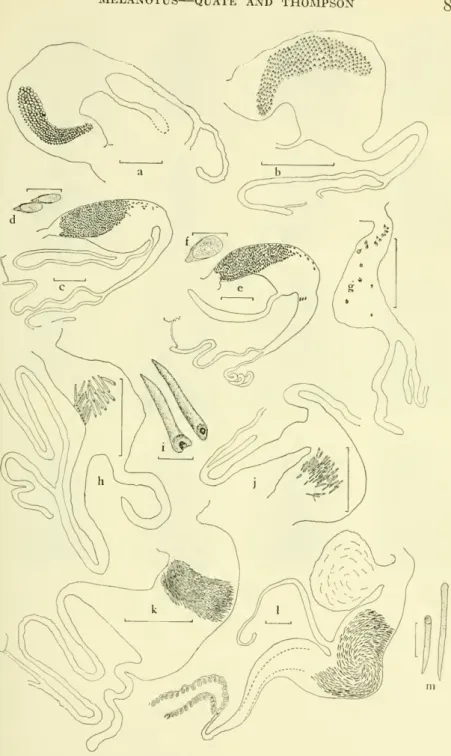Adaptation to the moister climate and edaphic conditions of the East may be responsible for maintaining this pattern. Most of the Melanotus are found in the eastern half of the United States, and this is where the greatest identification problems arise. Within some of the larger foveae there is a raised portion that gives them an ear-like appearance; the raised part is called the "foveal tragus".
While the senior author was a faculty member, funding was provided by the University of
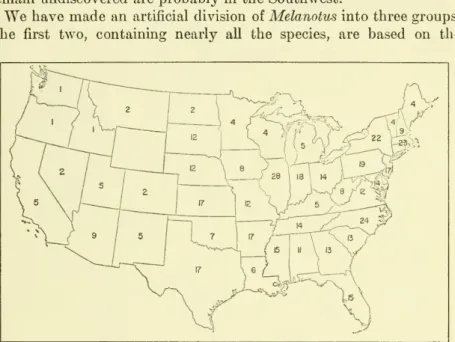
12 PROCEEDINGS OF THE NATIONAL MUSEUM
Pronotal punctures separated by no more than own diameter; flag segment elongated, d* antenna exceeding posterior angle by 3-4 seg-. Antenna and legs reddish brow and body black (teneral specimens with body dark forehead but darker than appendages); pronotum convex and rounded dorsally, rounded and concave at base of posterior angles; central pronotal punctures small and sparse; c. Paratennal fovea level; nasal flat; pronotal punctures very close together; cf paramere tapering and lateral line straight; color.
Pronotal punctures about as large as front; pronotum flattened and not rounded 27. trapezoid (part) Pronotal holes small, smaller than those on the front; pronotum.
NO. 35G8 MELANOTUS — QUATE AND THOMPSON 17
8 PROCEEDINGS OF THE NATIONAL
- Melanotus communis (Gyllenhal) Figures 4j, 9a,b; Plate Id
The female bursa is remarkably different from that of allied species in the complete absence of spines. With its large size and small segments of the second and third antennae, the male chestnut is not difficult to recognize; easily separated from ignobilis by the shape of the flagellar segments. Throughout the species there is sexual dimorphism with the female being larger, the edges of the pronotum less flattened laterally, the frontal margin without a projection, and the third antennal segment longer.
External characters of color and pronotal punctures are similar to communis, but the male genitalia are more similar to similis; the position of the spine on the female bursa is as in similis, but the shape of the spine is like that of communis.
Head: Anterior part with shallow anterior transverse depression, margin very narrow, not strongly projecting above clypeus, evenly rounded or flattened anteriorly, viewed from above; paratennal fovea small and shallow, nasal side flattened, width usually twice height. The internal genitalia of females are quite different from all other North American melanotes, and the genitalia of males are also markedly different from other species. The male and female genitalia of these smaller, lighter colored specimens are indistinguishable from ignobilis and are therefore treated as a section.
Body color dark reddish brown, covered with white or yellow hairs evenly distributed over the body. Head: Front with a pair of shallow anterolateral depressions not strongly projecting above clypeus, evenly rounded or slightly angled and flat when viewed from above, fovea crescentic, small but moderately deep and well defined; nasal obsolete. Antenna exceeding apex of posterior angle by 1 to 1.^ segments; reddish bro\vn, relationship between seg-.
- Melanotus morosus Candeze Figures 5h, lOe
- morosus is most likely to be confused with depressus. In general, morosus may be separated from that species by the small pronotal
- Melanotus hyslopi Van Zwaluwenburg Figures 51, 10/
- hyslopi and Sagittarius have larger parantennal fovea than any- other North American Melanotus and can be distinguished by that
A chne appears to exist in the males, with the size of the elytron decreasing towards the west and south, as shown in the following. The male genitalia are characterized by the angular paramere, rather than evenly rounded as in depressus, the moderately dense hairs at the apex of the paramere, and the fairly broad, tapering aedeagus. Antenna exceeds the tip of the posterior corner with )$ to iK segments, reddish brown, ratio of seg-.
Superficially, cribulosus resembles a member of the communis complex; however, the mandibular pit removes it from that group. Head: Front with shallow depressions, thick edge, dark reddish brown, not strongly bulging above clypeus, angular and blunt. Head: Anterior with a few shallow anterolateral depressions, not strongly bulging above the clypeus, angular to a truncated projection when viewed from above; parental fovea large.
Antenna exceeding tip of posterior angle by 2-3 segments, segment 3 intermediate to 2 and 4, reddish brown, flagellar segments rather elongated. Antenna short from tip of posterior angle with about 1 segment, reddish brown, segment 3 almost as long as 4.4 about IK times. Antenna long, exceeding tip of posterior angle by 3-4 segments, reddish brown, segment 3 intermediate to 2 and 4, flag segments slender, nearly parallel-sided, not toothed, segment 4 twice as long as maximum.
Pronotum wider than long; punctures in middle usually separated by distance equal to little less than own diameter, unequal to those at front; sides of pronotum straight with little or almost no anterior curvature and slightly divergent posteriorly; hind angles almost parallel to carina, usually extending cephalad from base of hind angles, Genitaha as depicted; parameres with apical blade. Head: Front with a few shallow anterolateral transverse depressions, margin not strongly projecting above clypeus, evenly rounded.
MELANOTUS QUATE AND THOMPSON 47 and well defined, semicircular; nasale protuberant, width 1 to IK times
The body color is reddish to dark reddish brown, covered with a white or yellowish coat, evenly distributed over the body. Antennae exceed tip of posterior angle by about half a segment; inner genitaha as drawn, bursa not prolonged or enlarged at base of accessory gland and mth more than 50 peghkespines. Antenna exceeding tip of posterior angle by half segment, reddish brown, ratio of segments segment 4 about twice as long as greatest width; straight men's hair short and thick.
Pronotum as wide as or a little wider than long; holes at center usually separated by distance equal to own diameter, unequal to that at front; sides of pronotum straight, subparaUel; posterior angles slightly divergent, carina usually well extending cephalad from base of posterior angle. Antenna not extending to tip of posterior angle; internal genitalia as represented, bursa with about 50 pin-like spines, elongated and enlarged at base of accessory gland, gland short and clavate. Antenna exceeding tip of posterior angle by about 1 segment, reddish brown, ratio of segments segment 4 about iKo times as long as maximum width;.
The antenna exceeds the tip of the trailing corner by about 1]^segments, red-brown^n, the ratio of segments segment 4 about 1}^ times as long as the maximum u^dth;. Pronotum about as long as wide, points in center usually separated by a distance equal to or less than the diameter of the owm, smaller than that in front, sides of pronotum straight behind the anterior curvature, almost parallel; posterior angles diverge, carina usually extends slightly from the base of the posterior angle. The slender thorax helps separate it from other species except lanceatus, but positive identification requires a study of the distinctive genitalia.
Antenna ending near apex of posterior angle with about 1 segment; configured internal genitalia. The relatively thin pronotum, which is as long as or longer than wide, and the thin extended frontal border are the main features that separate parallelus from other species of the americanus group.
NO. 3568 MELANOTUS — QUATE AND THOMPSON 53
Melanotus hamatus KnuU
Pronotum wider than long; punctures large as on obverse, compact, separated by less than own diameter; rounded sides with concavity in front of hind angles; posterior angles small, divergent. 60 NATIONAL MUSEUM PROCEEDINGS vol. 121 . angUate and flattened in front seen from above, sometimes depressed in the middle; parenteral fovealite, deep and crescentic, foveal tragus sometimes well developed; nasals usually developed but not strongly projecting, wider than high. Antenna light for dark brown and . lighter than the body in dark specimens, exceeding the apex of the posterior angle by 1 . to 1)2 segments, the ratio between segments flagellum usually strong, segment 4 approx. IK times as long as maximum width; strong, segment 4 approx. IK times as long as maximum width;.
Antenna exceeding apex of posterior angle by about half a segment; sides of pronotum generally rounded; bursa with numerous plaque-like spines, spermathecal duct branching at tip of biu-sa. 64 NATIONAL MUSEUM PROCEEDINGS vol. increasingly larger and darker and constituted the subspecies franciscanus. Although one of the smallest specimens of oregonensis in our material is from Pleasanton, Alameda Co., California).
Antenna reddish brown, exceeding apex of posterior angle by half a segment or less, segment 3 nearly 4, 4 about lY times as long as maxunum width; raises very short, fine male hairs, on the contrary. Pronotium about as wide as long; punctures in the anterior two-thirds as large as those in the anterior, and spaced equal to less than their diameter, those in the posterior one-third growing much smaller and denser; often giving it a granular surface appearance; sides of pro-notum vary from straight and divergent posteriorly to curved with slight concavity at base of posterior angle; posterior angles divergent, carina usuaUy lying cephalad of base of posterior angle and attenuate. The fine setae and punctures on the posterior part of the pronotum, the short antennae, and the moderately large size easily distinguish M.
Antenna extending to tip of posterior angle, segment 3 intermediate in size between 2 and 4; internal genitalia as shown, bursa with small cluster of pointed spines, accessory gland short and thicker than duct, spermathecal duct branching at about one-third base. Similar to male, but without variation in body color; antenna shorter than tip of posterior angle by about 2 segments, segment 3 intermediate in size between 2 and 4; internal genitalia as figured, bursa with cluster of spine-like spines, smaller and more numerous than in leonardi.
- Melanotus crihricollis Candeze Figures 7j, \2l,m; Plate IZ
Antenna exceeding apex of posterior angle by about segment K, segment 3 intermediate in size between 2 and 4, flagellar. Pronotum wider than long, setae very large and dense, separated by less than their diameter; sides of pronotum straight after anterior curvature and usually subparallel but may be divergent posteriorly; Posterior angles divergent, each with a strong elongate cephalad with base of posterior angle and bent anteriorly and a weak, shorter, median carina about % length of larger one. This species has subequal second and third antennal segments, a spreading frontal margin, densely fine pronotal setae, and a long, slender, heavily striated female bursa.
It is unlike any species we have encountered in North America and is not known to us. This species is usually listed as a synonym of similis (=Jissilis) or communis, but the types are apparently lost, and we cannot apply the name to a known species. Lane (in litt.) states that he saw specimens at the Deutschen Entomologischen Institut, Berlin, which may be the types.
According to Lane, these are the same as ignobilisand if those specimens could be called types, disregardus would fall as a synonym of ignobilis. This may just be a minor form of communism according to Lane. in the minority), who found specimens in the Museum Zoologische der Humboldt-Universitat that may be types. An illustrated descriptive catalog of the Coleoptera or beetles (exclusive of Rhynchophora) known to occur in Indiana.
73 Leng, C. W
76 PROCEEDINGS OF THE NATIONAL MUSEUM VOL. 121
78 PROCEEDINGS OF THE NATIONAL MUSEUM
80 PROCEEDINGS OF THE NATIONAL MUSEUM
